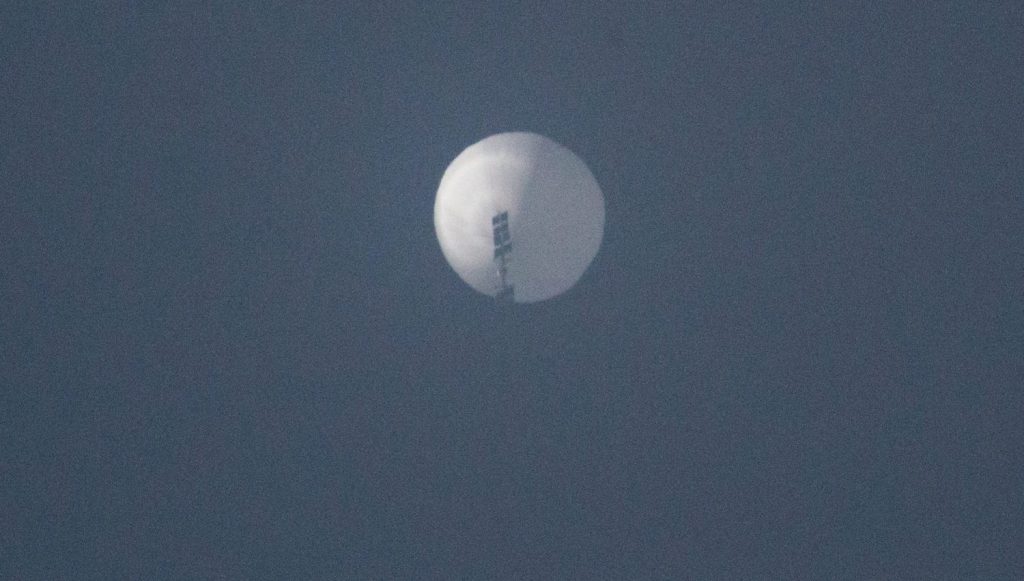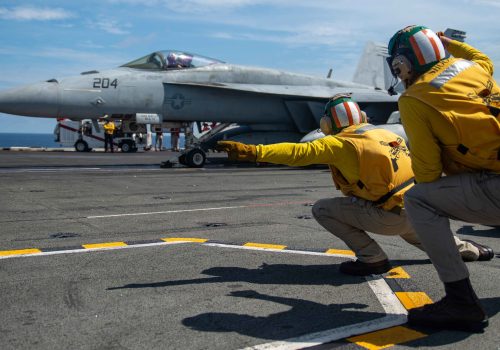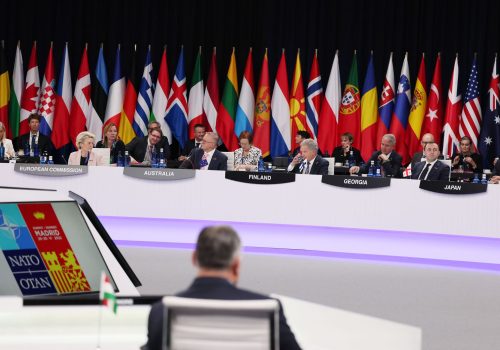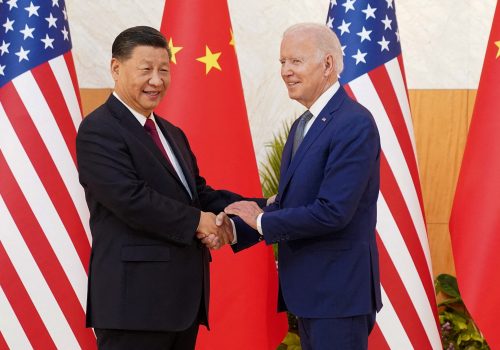This story was updated on February 4 after the balloon was destroyed.
It’s much more than hot air. US fighter jets shot down a suspected Chinese surveillance balloon over the Atlantic Ocean on Saturday after it had floated across the United States. US Secretary of State Antony Blinken had already canceled a planned trip to China amid concerns over the balloon. Beijing said the balloon was for civilian research and had gone far off course, but US President Joe Biden decided to shoot it down down after it was tracked above a sensitive nuclear weapons site in Montana. The scuttled trip would have been Blinken’s first to China in two years as secretary of state and reportedly would have included a sit-down with Chinese leader Xi Jinping. What happens to the world’s most important bilateral relationship now? Our experts, one of whom happened to be on the scene of the balloon brouhaha in Montana, are airing their thoughts.
1. What should happen now that the balloon has been shot down?
Now that the United States has taken down the People’s Republic of China’s (PRC) surveillance balloon over the Atlantic Ocean, there are three steps the United States should pursue:
- Recover and exploit the balloon for both intelligence and counterintelligence value, while also not squandering an opportunity to directly refute the PRC’s preposterous claims that this was a weather research balloon. In short, deny the PRC its implausible deniability, both for diplomatic purposes and to weaken the Chinese Communist Party’s (CCP) confidence in its own military and intelligence apparatus.
- Send a message about costs and red lines to the PRC through economic, military, and diplomatic actions both directly with the PRC and indirectly within the region and with the PRC’s global interests and partnerships. Encouragement of things like recent Czech overtures to Taiwan can be a part of this.
- Channel broad and near-universal outrage on this brazen (though likely nominally effective) act of collection from one hundred thousand feet to energize US public will against PRC intelligence overtures that are substantially closer to home. Those include collection risks and vulnerabilities such as TikTok, the Office of Personnel Management breach, collection of US genetic data, Huawei 5G, industrial/economic espionage, and even more invasive activities. Efforts to date for public support to counter such activities have simply not been effective enough to feed into a necessary whole of nation approach.
—Arun Iyer is a nonresident senior fellow with the Scowcroft Center’s Forward Defense practice and leads its project Adding Color to the Gray Zone.
2. What do you suspect is the real story behind the balloon?
US defense officials said the balloon has “limited additive value” beyond what the Chinese could gather from satellites. If this is true, then why did China take the risk? China must believe it provides additive value. In fact, it gave Beijing the ability to better map US intercontinental ballistic missile silos for future targeting and to gauge the US response. This action may suggest a shift in Chinese nuclear strategy to plan to target US nuclear weapons before they can be used, and it shows a brazen belief in Beijing that the CCP can violate US airspace without consequences.
—Matthew Kroenig is the acting director of the Atlantic Council’s Scowcroft Center for Strategy and Security and a former nuclear-weapons expert in the US Department of Defense and intelligence community.
Reports of a PRC surveillance balloon are troubling in the context of an increasingly emboldened PRC. Due to its self-perceived economic, diplomatic, and even military strength, the PRC continues to take steps that brazenly violate US sovereignty. The recently raided PRC police stations operating inside US cities, forcible repatriations from the United States through “Operation Fox Hunt,” and the cliché but no less alarming trend of economic and industrial espionage of US technologies all paint a picture that the PRC perceives that nothing of substance will come from the United States when protecting its own environment, due to the United States’ culture of freedom, economic interests, or just plain inertia. The cancellation of Blinken’s diplomatic engagement in China is appropriate but will not be enough.
—Arun Iyer
3. Why did the US take the dramatic step of canceling Blinken’s trip?
The Chinese spy balloon drifting over Montana caught my attention—Montana is my home state, and I teach Chinese politics here through the Mansfield Center at the University of Montana—but the reality is there are a lot of other equally serious challenges to the fraught US-China relationship that made a Blinken visit to Beijing already very problematic.
Among those are disagreements between the two countries over human rights, China’s mercantilist trade practices, its economic support for Russia, and the future of Taiwan. But what is likely front and center right now is the ongoing battle over who will lead in the development of advanced technology such as artificial intelligence, quantum computing, and semiconductors. The news that Washington may impose new restrictions on sales of US technology to Huawei is just the latest salvo among many that the Biden administration has taken to block China’s technological rise, including most recently convincing the Netherlands and Japan to ban the sale to China of machinery to make advanced semiconductors.
—Dexter Tiff Roberts is a senior fellow at the Indo-Pacific Security Initiative in the Scowcroft Center and a former China bureau chief for Bloomberg Businessweek.
4. What are the consequences of canceling the trip?
While no one expected significant outcomes from Blinken’s visit to China, it was viewed as an essential step in building on positive momentum in the bilateral relationship following the Biden-Xi meeting at the Group of Twenty (G20) summit in November. It was also intended to gird freshly restored communications channels against the already evident storm clouds ahead this year related to tech competition, economic policy, and Taiwan.
Just this week, we had China strongly warning US House Speaker Kevin McCarthy against visiting Taiwan this spring, US General Michael Minihan’s leaked memo telling troops to be ready for a fight over Taiwan in the next two years, and China’s furious if predictable reaction to new Czech President Petr Pavel’s call to Taiwan President Tsai Ing-wen upon his election—a first for a European Union head of state.
The postponement of the trip, while arguably justified, complicates the administration’s efforts to ensure the newly reinforced “floor” under the relationship holds for more than a few short months.
—David O. Shullman is the senior director of the Global China Hub and a former US intelligence official focused on East Asia.
5. Aside from canceling the trip, how else can the United States respond?
The United States should take action to limit the ability of China to gain sensitive information from the balloon. If shooting down the balloon is too dangerous, for example, the Pentagon may be able to use non-kinetic means to disable on-board equipment or shield sensitive sites. The United States should also make sure that the CCP pays a price. Blinken postponing his visit is a helpful first step.
—Matthew Kroenig
The United States must take appropriate, firm, and relevant moves against these brazen actions, or else it invites them to multiply. The United States must not accept the thinnest plausible deniability that the PRC uses to avoid repercussions for actions such as these, while maintaining false equivalencies by invoking principles such as Innocent Passage under international law. A decade into a militarized and pressurized South China Sea, after the global acceptance of the PRC’s denials and assurances that it had no military intentions or applications there, should make it painfully obvious that the United States must do much more to push back against this increased aggression, and it must draw red lines with actions and costs, not words.
—Arun Iyer
Further reading
Fri, Feb 3, 2023
Is the US over-militarizing its China strategy?
New Atlanticist By Harlan Ullman
China lacks the capability to seize and occupy Taiwan with an amphibious invasion, but the US spends inordinate time and money preparing for one. It's time to rethink the strategy.
Thu, Feb 2, 2023
Implementing NATO’s Strategic Concept on China
Report By
Allies made it clear that they consider Russia their most immediate and direct threat. Yet they also made headlines by addressing challenges emanating from the People’s Republic of China (PRC).
Mon, Nov 14, 2022
What did Xi and Biden just accomplish?
Fast Thinking By
Our Sinologists read between the lines of the diplomat-speak following the US president and Chinese leader's meeting in Bali.
Image: A balloon flies in the sky over Billings, Montana, US February 1, 2023 in this picture obtained from social media. Chase Doak/via REUTERS




